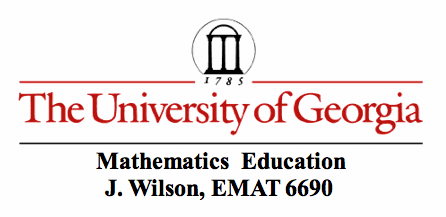

Quadrilaterals are interesting shapes. The one characteristic of quadrilaterals that we will be investigating in this essay is the quadrilateral formed by connecting the midpoints of each side.
The figure above shows us a picture of such a situation. We have the quadrilateral ABCD and the quadrilateral EFGH. From the picture above it seems that the quadrilateral EFGH may in fact be a parallelogram. Let's see if this still seems to be true as we change the shape of our original quadrilateral ABCD (See figures below).

Even after we have changed the shape of our quadrilateral ABCD, the quadrilateral EFGH still appears to be a parallelogram
Can we prove this??
Let's give it a shot. First we will create the diagonal AC of quadrilateral ABCD. We will now just focus on the triangle ABC shown below.
From the construction of segment EF, we know that BF = FC and AE = EB. Now we can extend the segment EF (see figure below). We can then create a line through C which is parallel to segment AB. We then know that angle BFE and angle IEC are vertical angles and therefore congruent. We also know that angle FBE and angle ICF are alternate interior angles and therefore congruent. Therefore, triangle EBF and triangle ICF congruent by the SAS Theorem.
Since the two triangles are congruent we can conclude that segment IC is congruent to segment EB. However, E is the midpoint of segment AB. Thus, IC is congruent to AE as well. Then since AE is congruent to IC and parallel, then we know that angle EAC is congruent to angle EIC and angle AEI is congruent to angle ACI. Therefore, AECI is a parallelogram and segment EF is parallel to segment AC.
Using similar reasoning, we now can prove that segment GH is parallel to AC as well. Thus, EF is parallel to GH.
We can once again, use the same reasoning to conclude that segment EH and segment FG are both parallel to the diagonal BD and thus parallel to each other. We can then conclude that since we have two pairs of parallel sides that the quadrilateral formed by connecting the midpoints of the quadrilateral ABCD will always be a parallelogram.
We could continue the process of creating the parallelograms and get a figure such as the one below.
There is another interesting property which parallelogram EFGH obtains. First of all, let's look at the areas of both figures when we have the diagonals of ABCD both showing. By constructing those diagonals, we have separated the area of quadrilateral ABCD into four different pieces. Let's take a look the section in the top right. There we see that the diagonals and the sides of parallelogram EFGH form a smaller parallelogram GKJL. (We know that GKJL is a parallelogram by the same reasoning that we used above.) We can then construct the diagonal KL of the smaller parallelogram GKJL.
From here we know that the diagonal of a parallelogram will divide the area of the parallelogram into two equal pieces. We also know that since KG is parallel to JD that angle CGK and angle GDL are congruent since they are corresponding angles. By similar reasoning, angle GCK and angle DGL are also congruent. We also know that angle LKG and angle CGK are congruent since CK is parallel to GL and those angles are alternate interior angles. Similarly, angle KGL and angle GLD are alternate interior angles and congruent. However, angle KGL and angle GKC are also alternate interior angles. Thus, angle KGL is congruent to angle GLD and angle GKC. Triangle CKG and triangle KGL share the side KG. So by ASA Theorem, the two triangles are congruent. Similarly, triangle GLD and triangle KGL share side GL. Thus, by ASA Theorem the two triangles are congruent.
So at this point we have proven that triangle KGL is congruent to triangle KJL, triangle CKG, and triangle GLD. Thus, the area of triangle KJL + area of triangle KGL = area of triangle CKG + area of triangle GLD.
We have now shown for that fourth of our quadrilateral ABCD the parallelogram JKGL is half the area of that fourth of the quadrilateral ABCD (triangle JCD). We could then use the same reasoning to prove that the area of parallelogram FKJM is half the area of triangle BCJ, the area of parallelogram JMNE is half the area of triangle ABJ, and the area of parallelogram NHLJ is half the area of triangle AJD.
Thus, the area of parallelogram EFGH is half the area of our original quadrilateral ABCD.
Return